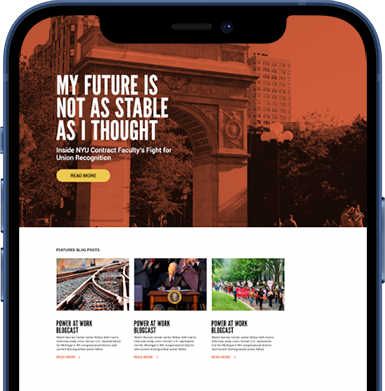The recent wave of unionization at Starbucks represents a dramatic shift in U.S. labor organizing. Through worker-to-worker outreach, workers successfully unionized over 500 stores employing more than 10,000 baristas. This one-on-one worker-led model is the labor movement’s future, according to Eric Blanc’s new book We are the Union: How Worker-to-Worker Organizing is Revitalizing Labor and Winning Big.
The traditional union organizing method was to dispatch an organizer when workers reached out or when a union launched a concerted campaign at a major employer. This was expensive and, if a victory came, it could bring union representation to workers, or if lost, union resources were drained. This model works great for large concerns that employ thousands. How do you organize nationally operated small businesses with fewer than 25 workers? Blanc’s answer – electronically, worksite by work site.
Blanc argues that by using mass online training and digital tools, workers can self-organize, worker to worker, shop to shop, without the traditional organizer riding into town. He cites examples from media, fast food and warehouse workers.
The national Starbucks effort started humbly at one store in 2021 in Buffalo, New York. Starbucks appealed to the National Labor Relations Board (NLRB) for a citywide unit with all Starbucks workers voting – a measure that would have required organizing all the stores simultaneously thereby potentially killing the union drive. The NLRB rejected the company’s proposal. One store’s workers successfully voted to unionize. As word spread through social media, Buffalo Starbucks organizers soon found themselves inundated with messages from other workers around the nation. Rather than waiting for a union organizer, these Starbucks workers operated member-to-member, instructing each other in their union rights, how to file for an election and how to organize their shop.
Workers United, formerly the Union of Needletrades, Industrial and Textile Employees (UNITE), now a division of the Service Employees International Union, provides support, legal expertise and a national touchstone to the struggling baristas. But the union drives have been locally originated and sustained by worker-to-worker outreach.
The Strategic Organizing Center prepared materials for a union challenge at a Starbucks stockholder’s meeting. This report documented that Starbucks resisted the union drives and spent an estimated $240 million in its anti-union effort, racking up 2,482 alleged labor law violations, with 133 formal complaints issued by the NLRB. Over 200 union activists were fired.
The company’s efforts could not overcome social media negativity against the coffee chain. Sales and stock prices fell, and the public soured on the ubiquitous coffee company, despite its constant advertising campaigns. Starbucks changed course and is now negotiating a national contract, although Starbucks Workers United launched strikes in December 2024 because of the company’s dilatory tactics at the bargaining table

Starbucks workers at the College Hill location in Normal, IL voted unanimously to unionize in December, 2024. Photo Credit: Laynie Ferriman.
Blanc shares multiple worker-to-worker efforts, including those among media employees, warehouse workers, and other coffee and fast food chains. He points out that in a decentralized economy, where over 80 million workers are in businesses with fewer than 249 workers, labor does not have the resources to dispatch organizers to every workplace where workers are ready to organize.
Worker-to-worker organizing success requires decentralized decision-making. People who organize their own shop are going to speak their mind. In the Starbucks campaign, supporting LGBTQ workers, especially trans individuals, was a central concern for the young workforce, along with speaking out against the war in Gaza. Many union activists were radicalized by the Black Lives Matter movement and are anti-capitalist, radical and progressive in their politics. An astute national union seeking to organize requires sensitivity to these concerns and respect for the workers and union democracy. This creates creative tension between national organizations and workers who are challenging traditional union practices. In the Starbucks case, workers at individual stores are allowed to witness national negotiations online and raise issues as bargaining progresses.
Blanc argues that the traditional union organizing model is certainly valid in larger, concentrated workplaces. If the labor movement is going to survive, it must grow. Organic, locally led drives are key to that success. President Joseph Biden’s NLRB appointees were very sympathetic to union organizing and supported these efforts. Whether or not President Donald Trump’s appointees will show the same support will unfold in coming months.
Blanc concludes that organized labor must embrace these new efforts and “start acting like a movement again.” He writes that “[e]stablished unions should start systematically providing tools and funds so that millions of workers can self-organize and train others.”
Currently, unions represent fewer than six percent of private sector workers. To stay relevant with a changing workforce and economy, unions must adjust. In the 1930s, the American Federation of Labor’s craft model was challenged by the Congress of Industrial Organization’s mass union efforts. Eventually, both embraced organizing workers by industry and the movement grew. Rather than simply waiting for labor law reform or political change, Blanc’s advice is to seize the momentum now and let worker self-organizing propel and perhaps save U.S. unions.
As someone who prepared hard-copy materials for both union and political organizing campaigns, worker-to-worker messages were always my default – they are the most effective messages. In this wired age, the opportunities are boundless for worker-to-worker communication, building power directly in the workplace. Blanc well summarizes how powerful these tools are and the opportunity they present to build union power from the ground up.
We are the Union: How Worker-to-Worker Organizing is Revitalizing Labor and Winning Big by Eric Blanc is available through the University of California Press

